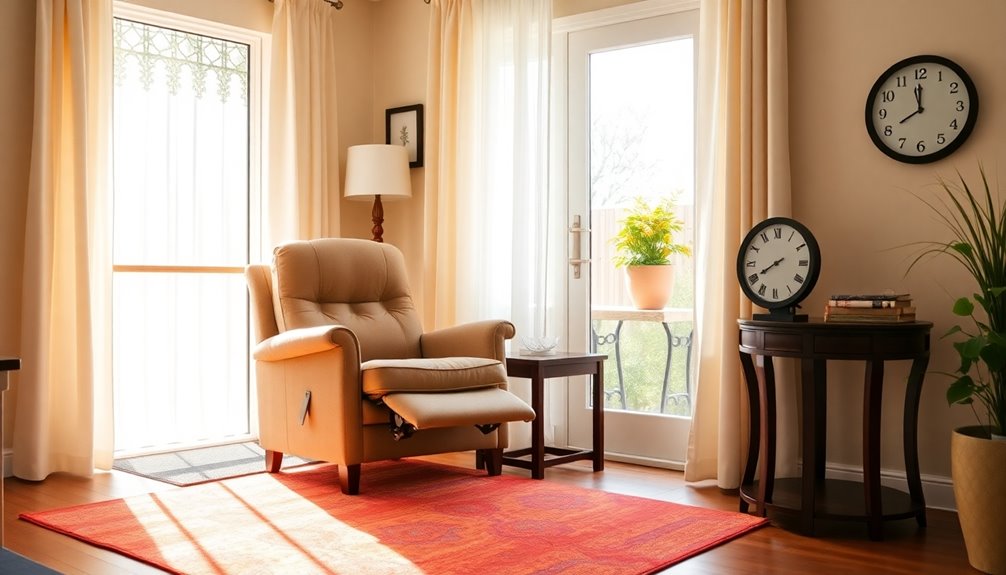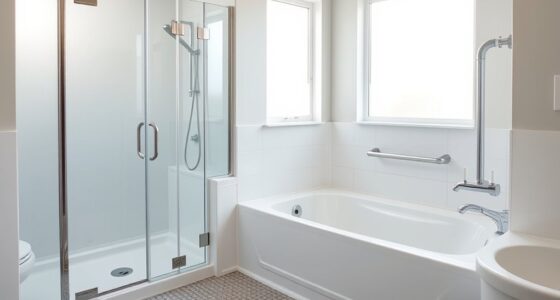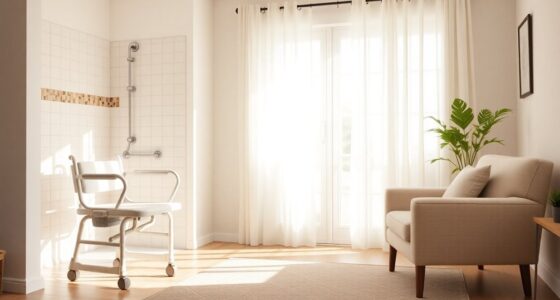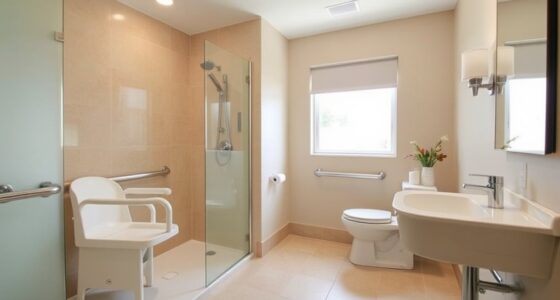You won't believe how simple hacks can boost accessibility in elderly homes! Start by clearing pathways for easy navigation, and use contrasting colors to improve visibility. Strategically place grab bars in essential areas and opt for non-slip flooring to prevent falls. Smart home technology can make everyday tasks easier, while curbless showers and roll-under sinks enhance comfort and accessibility. Plus, consider bed heights for easier transfers. Stick around to discover even more clever ideas to create a safer home!
Key Takeaways
- Install grab bars in key areas like bathrooms and hallways to provide support and enhance safety during movement.
- Utilize color contrast on walls and floors to improve visibility and help elderly individuals navigate spaces more easily.
- Opt for adjustable furniture, like beds and chairs, to facilitate easier transfers and promote independence for individuals with mobility challenges.
- Implement smart home technology for voice-activated controls, enabling easy management of lights and emergency alerts without physical strain.
- Use non-slip flooring and secure area rugs to minimize the risk of slips and falls, ensuring safer living environments.
Clear Pathways for Safe Navigation
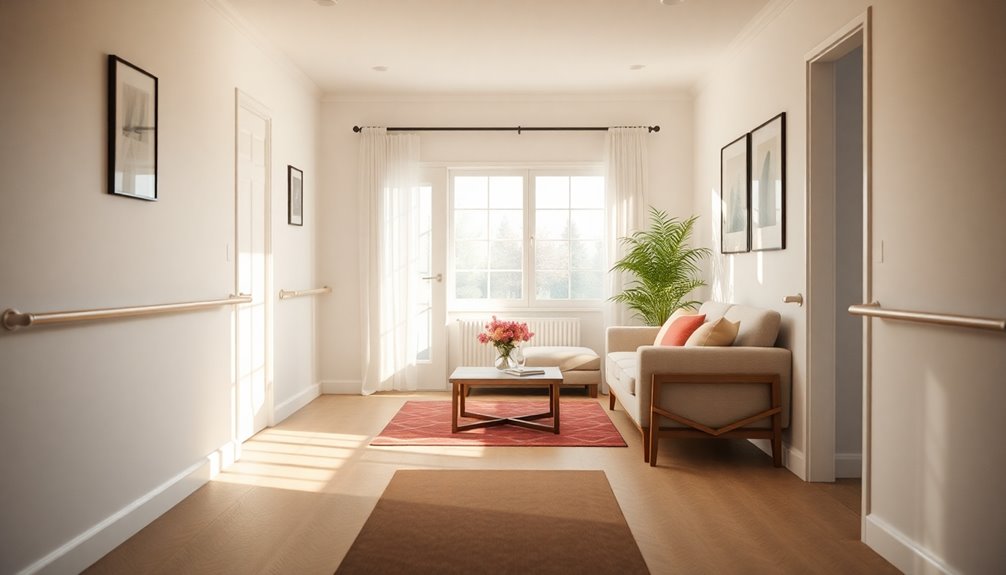
To guarantee your home is safe and navigable for elderly individuals, you should prioritize creating clear pathways.
Start by ensuring all pathways are at least 36 inches wide. This accommodates wheelchair users and allows easy navigation for everyone.
Remove clutter, furniture, and decorative items from hallways to minimize tripping hazards.
Install grab bars and handrails along staircases and hallways; these provide essential support and stability.
Keep doorways and thresholds level and free of obstructions to facilitate smooth passages throughout your home.
Color Contrast for Enhanced Visibility
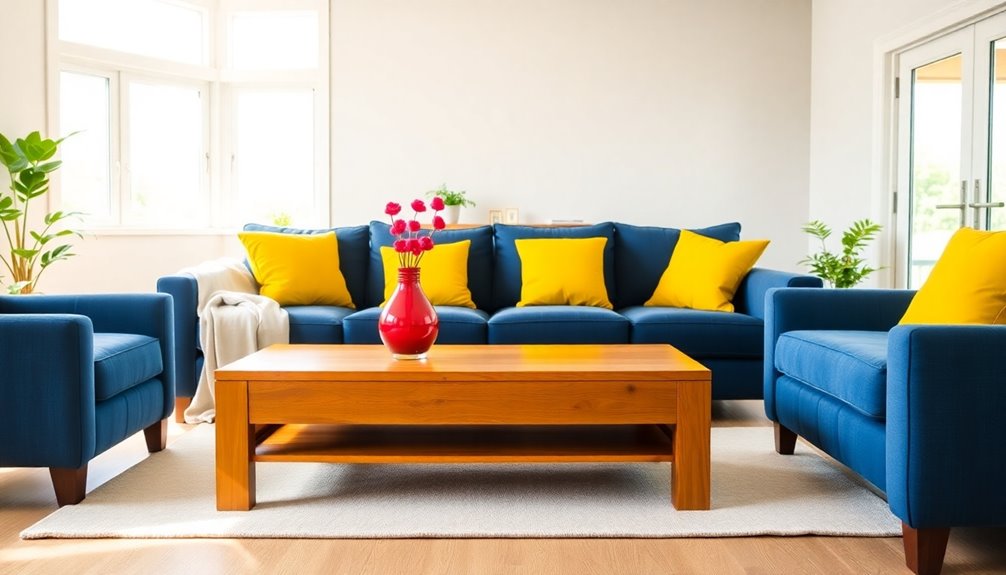
Creating clear pathways is just the beginning of making a home safe for elderly individuals. Utilizing color contrast can greatly enhance visibility, helping you navigate your home with confidence. Aim for a color contrast ratio of at least 70% between adjacent surfaces. This can make a big difference in recognizing key features like door frames and light switches.
Here's a simple guide to effective color contrast:
| Area | Recommended Colors | Purpose |
|---|---|---|
| Walls | Light and dark hues | Distinguish spaces |
| Floors | Dark floors, light walls | Safety and navigation |
| Furniture | Bright colors | Easy object recognition |
| Accessories | Vibrant shades | Memory aid for usability |
Implementing color contrast not only boosts safety but also enhances your home's aesthetic appeal.
Strategic Placement of Grab Bars
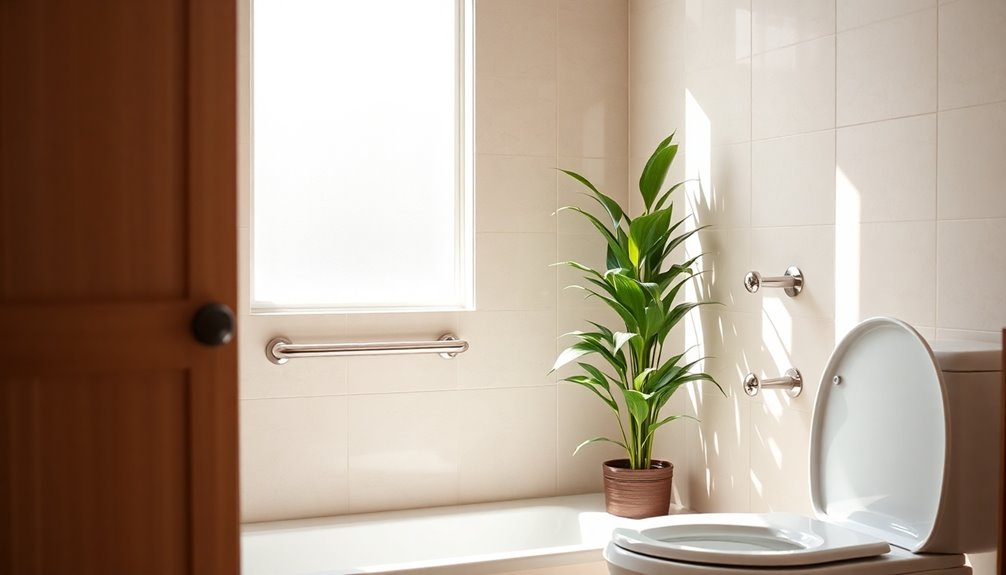
Strategically placing grab bars in your home can considerably enhance safety for elderly individuals.
Install grab bars near toilets and in showers or bathtubs to provide essential support during transfers, ideally positioned 33 to 36 inches above the floor. End-of-life care options can also be considered to ensure that safety measures are in place as needs evolve.
Verify these bars are securely anchored to wall studs to withstand the user's weight and made from slip-resistant materials.
To keep your bathroom looking cohesive, select grab bars that complement other fixtures, blending functionality with aesthetics.
The strategic placement of grab bars should also verify they're easily reachable and don't obstruct movement.
Regularly assess your installations to maintain effectiveness and safety, adapting as the needs of elderly residents change over time. Additionally, consider how mandatory mediation can help resolve any disputes regarding modifications in the home environment for better accessibility.
Non-Slip Flooring Solutions

When it comes to creating a safe home for elderly individuals, choosing the right flooring is essential.
You'll want to contemplate non-slip materials, rug safety tips, and proper installation and maintenance to minimize the risk of slips and falls.
Flooring Material Options
Choosing the right flooring material can greatly enhance safety in elderly homes, especially when it comes to non-slip options. Non-slip flooring materials, like vinyl and textured rubber, provide excellent traction to help prevent slips and falls. Additionally, selecting appropriate materials can further reduce the risk of accidents and improve overall home safety.
If you're considering carpets, low pile options are your best bet; they offer better stability and reduce tripping hazards. For a stylish touch, go for tile flooring with a matte finish, which enhances grip without compromising aesthetics.
Additionally, if you have area rugs, make sure they're secured with non-slip mats or adhesives to keep them in place. Finally, consider incorporating non-slip treatments on existing surfaces to improve safety without the need for a full renovation. Implementing these non-slip flooring solutions can significantly contribute to a safer living environment for the elderly.
Rug Safety Tips
Rugs can add warmth and style to your home, but they also pose safety risks for the elderly. To keep your space secure, consider these rug safety tips:
- Choose low pile rugs for better traction.
- Use non-slip mats underneath all area rugs.
- Make certain rug edges are flat and secured.
Make sure to select rugs with rubber backing, as they help keep them in place, making them easier to use. Additionally, incorporating natural materials like wood in your decor can also contribute to a safer and more inviting atmosphere. Continuous flooring in high-traffic areas is often recommended for enhanced safety, providing a smooth surface that minimizes tripping hazards. It's important to involve loved ones in discussions about end-of-life care options to ensure their comfort and safety preferences are respected.
If you're focusing on aging in place, consider continuous flooring in high-traffic areas to enhance safety.
Additionally, installing grab bars nearby can provide extra support when maneuvering your home. With these adjustments, you can enjoy a stylish yet safe environment for your loved ones.
Installation and Maintenance
To create a safer environment for elderly residents, opting for non-slip flooring solutions is essential. Textured vinyl or rubber flooring greatly reduces the risk of slips and falls, making them perfect for elderly homes. Additionally, incorporating HEPA filtration systems can improve indoor air quality, which is beneficial for the overall health of elderly residents.
When you install low pile rugs with non-slip backing, you guarantee they provide traction without hindering mobility. Consider using no-slip mats under area rugs, especially in high-traffic areas, to enhance stability. Additionally, choosing low maintenance materials can help ensure that the flooring remains safe and functional over time.
Regular maintenance is key; clean non-slip coatings and inspect for wear to maintain their effectiveness over time. Additionally, implementing preventive measures against slips can further enhance safety in elderly homes.
If you're looking for a cost-effective solution, consider incorporating non-slip treatments like anti-slip sprays on existing floors. This way, you improve safety without needing a complete flooring replacement, keeping your elderly home both functional and secure.
Smart Home Technology for Easy Control

As you explore ways to enhance comfort and safety at home, smart home technology offers a powerful solution for easy control. With voice-activated systems, you can manage your environment effortlessly, promoting independence.
Consider these benefits:
- Emergency Alert Integration: Quickly call for help with voice activation.
- Customizable Settings: Adjust brightness and volume to suit your needs.
- Routine Automation: Set schedules for lights and medication reminders.
Smart appliances with large buttons and clear displays cater to those with visual impairments, making them user-friendly.
By incorporating smart home devices, you'll not only boost safety but also simplify daily tasks, ensuring a more comfortable living experience.
Embrace the convenience and control that smart home technology brings to your life!
Accessible Furniture Arrangement
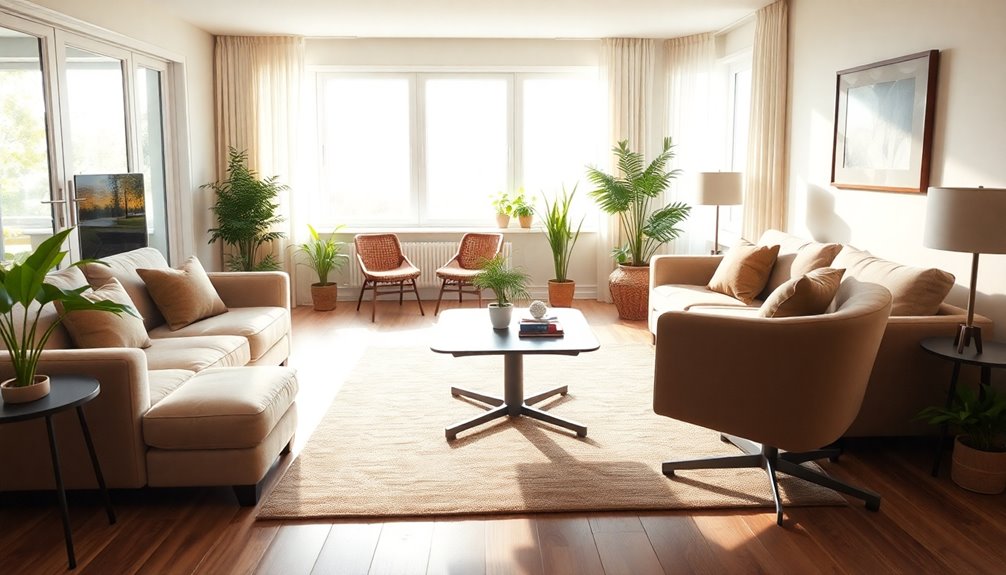
When arranging furniture, you should prioritize clear pathways to make navigation easier for individuals with mobility challenges. Guarantee there's at least 36 inches between pieces, and choose adjustable furniture heights that suit your needs, making sitting and standing more comfortable. Additionally, consider implementing safe sleep guidelines to ensure a secure environment for elderly individuals who may require assistance during sleep.
Optimize Pathway Clearances
Creating an accessible living space is essential for guaranteeing safety and comfort for elderly residents. By optimizing pathway clearances, you can enhance mobility and reduce the risk of accidents.
Consider these space planning tips:
- Maintain at least 36 inches of clearance between furniture pieces.
- Guarantee door frames and pathways are at least 32 inches wide.
- Avoid overcrowding with furniture; opt for multi-functional pieces.
Arranging furniture to create clear paths from room to room helps prevent falls and enhances safety.
Implement rounded corners on furniture to minimize injury risks in tight spaces. By carefully planning your space, you'll create a more accessible and welcoming environment for elderly residents, allowing them to navigate their home with ease.
Adjustable Furniture Heights
Adjustable furniture heights can make a world of difference in guaranteeing comfort and accessibility for elderly individuals. By choosing beds and chairs with adjustable heights, you enable easier transfers in and out of furniture. This flexibility helps accommodate various mobility levels, allowing users to maintain an ergonomic position that enhances their comfort.
Additionally, consider the height of key pieces like dining tables and desks to ascertain they're suitable for wheelchair users and those with limited mobility. Creating a living environment with adjustable furniture promotes independence and safety, adapting to the changing needs of the elderly over time.
When planning your space, verify pathways around adjustable furniture allow for easy movement and comply with accessibility standards for peak maneuverability.
Curbless Showers for Barrier-Free Access
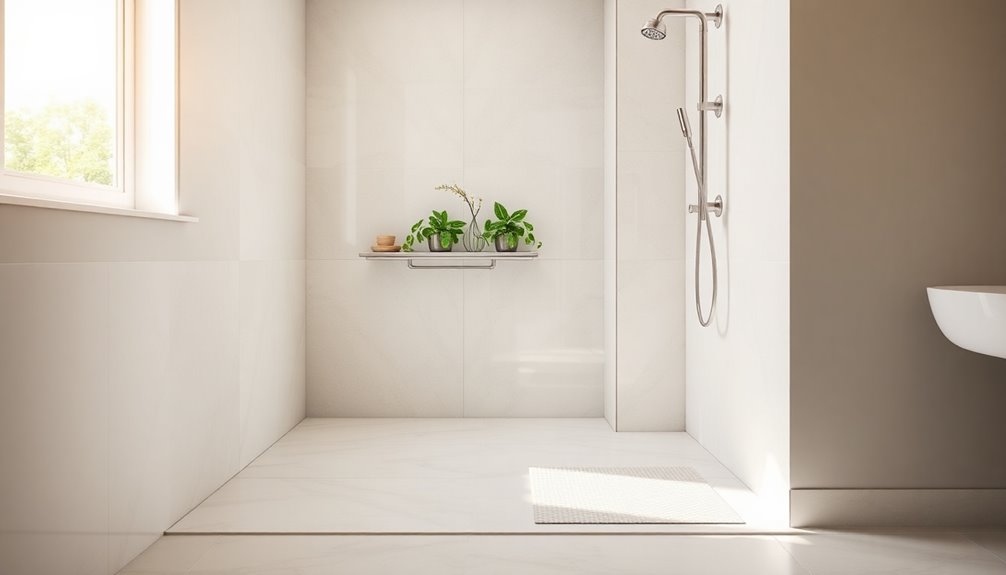
Curbless showers offer a seamless shift into bathing spaces, making them ideal for individuals with mobility challenges. By eliminating barriers, these showers make it much easier to access the bathing area, whether you're using a wheelchair or a walker.
Here are a few benefits of curbless showers:
- Safety: Non-slip flooring minimizes the risk of slips and falls.
- Customization: Adjustable showerheads and built-in seating enhance comfort.
- Aesthetics: Grab bars can be integrated stylishly without compromising design.
With careful planning to guarantee proper drainage, including a gentle slope, curbless showers become a functional and stylish choice.
Embracing this design can markedly improve the bathing experience for elderly users.
Roll-Under Sinks for Inclusive Design

When designing a bathroom for elderly users, roll-under sinks are an excellent choice for promoting independence and accessibility.
These sinks allow individuals in wheelchairs to comfortably position themselves underneath, enhancing usability. It's vital to contemplate the height and depth, guaranteeing plumbing isn't obstructive. Additionally, incorporating universal design principles can create an environment that is usable for people of all ages and abilities. The integration of smart bathroom technologies can further enhance the overall experience by providing features that cater to individual needs.
By pairing roll-under sinks with accessible faucet designs, like lever or touchless options, you make it easier for everyone to use the space. Incorporating voice commands for faucets can further enhance the experience, allowing users to turn water on and off without needing to reach.
Furthermore, accessible storage solutions beneath the sink guarantee that essential items are within easy reach, catering to diverse needs and promoting a functional, inclusive bathroom environment. Implementing home improvement strategies can significantly improve the overall comfort and safety of the space.
Appropriate Bed Heights for Comfort
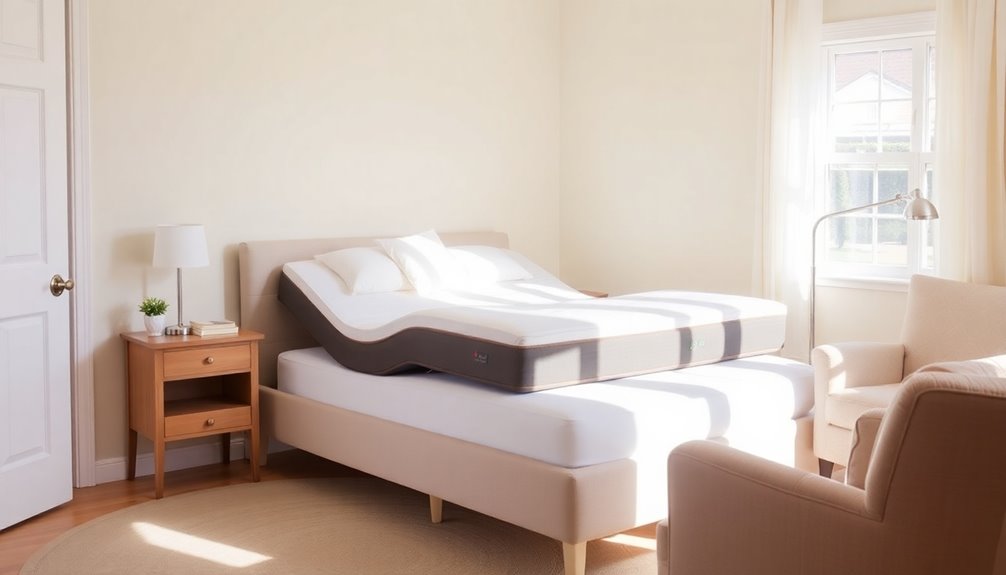
Finding the right bed height is essential for your comfort and safety as you age. An ideal bed height ranges from 18 to 24 inches, making it easier to get in and out without strain.
Here are some key tips to create spaces that enhance your sleeping experience:
- Choose adjustable beds for customizable height options based on your mobility needs.
- Install bed rails or grab bars to assist with stability when getting in and out.
- Regularly assess and adjust the bed height as your joint health changes.
A bed too low can make rising difficult, while one too high increases fall risks.
Prioritizing the right height keeps you safe and comfortable, ensuring a good night's sleep.
Textured Surfaces for Better Orientation
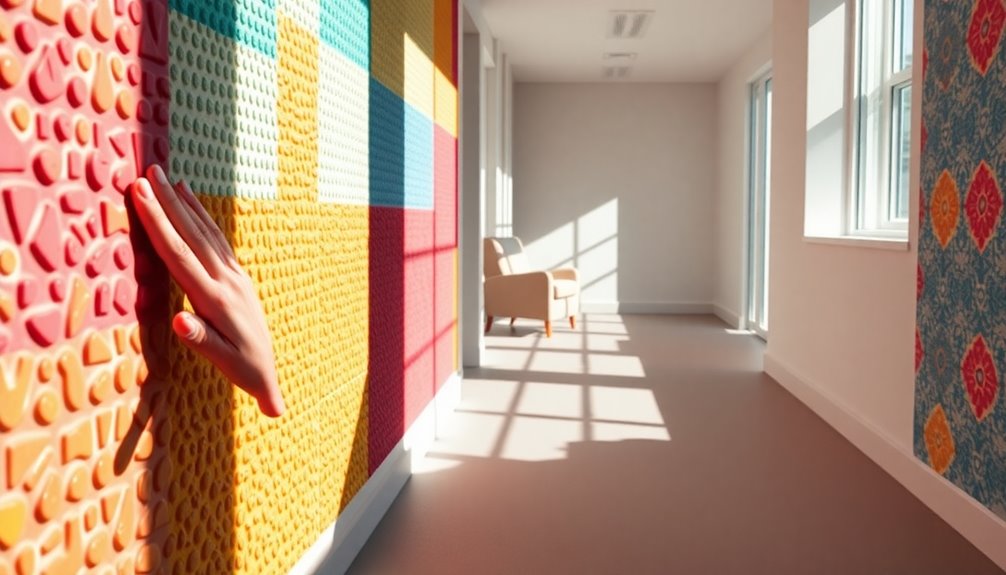
When you incorporate textured surfaces in your home, you create a more manageable environment for elderly individuals. Tactile pathway indicators can guide movement, while varied texture applications help distinguish different areas, enhancing orientation. This thoughtful approach not only improves safety but also boosts confidence in traversing daily spaces. Additionally, creating humidity levels that are comfortable can enhance overall well-being, as many indoor plants help regulate moisture in the air.
Tactile Pathway Indicators
Tactile pathway indicators, like textured surfaces, play an essential role in enhancing navigation for elderly individuals, especially those with visual impairments. By incorporating these features, you can greatly improve safety and confidence in your home.
Here are some benefits to take into account:
- Helps distinguish between different areas, like doorways and stairs
- Reduces the risk of falls and accidents
- Easy to maintain while remaining visually appealing
Using materials like rubber, carpet, or tiles guarantees durability and grip.
Implementing tactile pathway indicators is a cost-effective way to boost accessibility without sacrificing style. Not only do these textured surfaces provide essential sensory feedback, but they also create a safer living environment for your loved ones.
Varied Texture Applications
To enhance orientation for elderly individuals, incorporating varied textures in your home can make a significant difference.
Start by using rougher materials for handrails and smoother finishes for walls to aid those with visual impairments. Consider textured flooring with raised patterns or directional cues, helping elderly individuals navigate safely through their living space.
Pair contrasting textures on furniture, like a soft fabric sofa with a hard, smooth coffee table, to boost spatial awareness. Rounded edges on furniture not only improve safety but also provide tactile feedback, allowing individuals to identify objects more easily. Additionally, ensure that the area around the wood stove is kept clear of flammable objects to promote fire prevention techniques in the home.
Frequently Asked Questions
How to Make a House Wheelchair Accessible?
To make your house wheelchair accessible, start by widening doorways to at least 32 inches and removing thresholds for smooth passages.
Install grab bars in bathrooms and hallways at the right heights.
Opt for curbless showers with slip-resistant flooring for safe access.
Design your kitchen with roll-under counters and sinks, keeping essentials within easy reach.
Finally, choose low-pile rugs and non-slip flooring to reduce tripping hazards and enhance safety throughout your home.
What Is an Example of Accessibility for Disabled People?
Imagine a world where every barrier crumbles at your feet!
One fantastic example of accessibility for disabled people is a curbless shower. It's like stepping into a luxurious spa, where you glide in effortlessly, no obstacles in sight.
Add grab bars that blend seamlessly with the decor, and you've got both safety and style. Plus, roll-under sinks make daily tasks easier.
Accessibility transforms your space into a haven of comfort and independence.
Conclusion
By implementing these clever accessibility hacks, you're not just making a house; you're creating a nurturing garden where everyone can thrive. Each adjustment, from clear pathways to smart home technology, acts like sunlight, fostering independence and comfort for elderly loved ones. When you embrace these changes, you're ensuring their home becomes a safe haven, a vibrant space where they can navigate freely and enjoy life to the fullest. Let your home bloom with care and accessibility!
